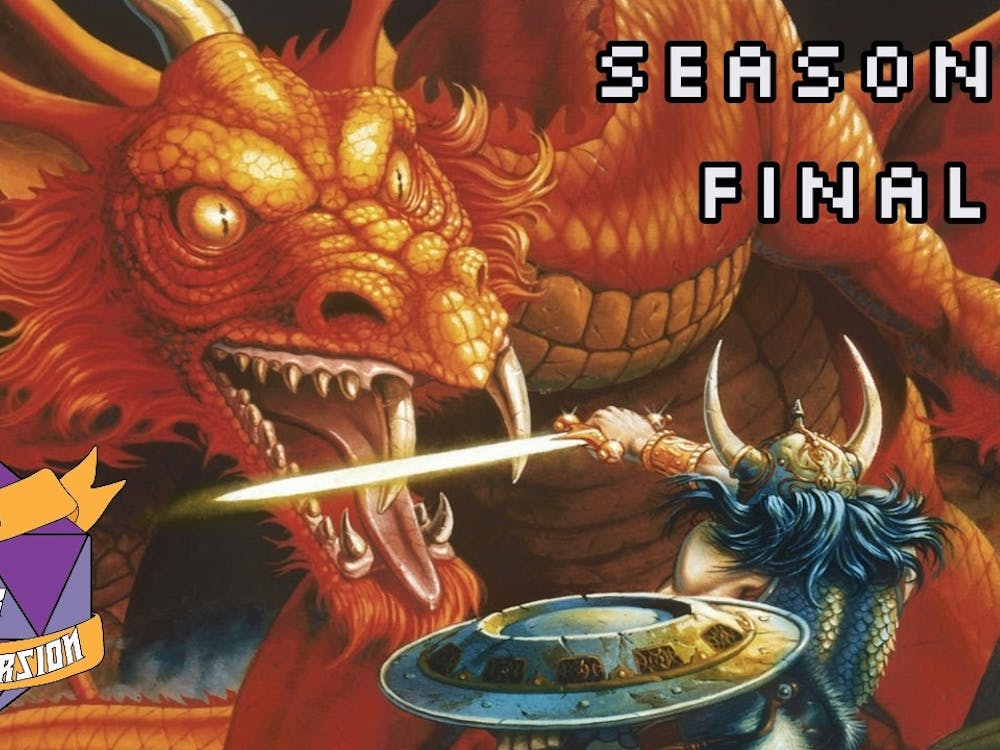The opinions and views expressed in this article are those of the author and do not reflect the opinion of Byte or Byte’s editorial board.
Author’s Note: This article does contain spoilers for a few books and series. If you’re interested in anything covered in this feature, I suggest not reading that section if you don’t want to be spoiled.
What comes to your mind when you hear “vampire”? Chances are you probably think of a pale, dark haired, often good-looking individual that has weird colored eyes and fangs. Or you might be thinking of a person who sparkles. No matter what you think of, you probably have some sort of favorite vampire story or character. Over the last few decades, vampires have stepped into the pop culture spotlight. Every movie, every TV show, and every book all have different interpretations of these monsters.
Throughout pop culture history, authors, directors and artists have had their own interpretations of these bloodsucking monsters. You have vampires who only drink the color red, vampires who sparkle in the sunlight, vampires who have tattoos on their foreheads, and you even have dhampirs. This feature will break down some unique takes on vampires. I’ll start with the father of vampires and where this monster got its start and I’ll end it with my favorite interpretation of these creatures.
Dracula
It wouldn’t be a vampire feature if I didn’t include the original bloodsucker. Dracula was originally written in 1897 by Irish born author, Bram Stoker. It’s common knowledge that this Dracula is based off of an actual person, Vlad III or most commonly known, Vlad the Impaler. Stoker’s interpretation is what everyone is most familiar with. These vampires are undead creatures who hunt for fresh human blood. Other notable features of these vampires are their immortality, lack of reflection, weakness to sunlight, aversion to garlic and of course, fangs. Shapeshifting into a bat is also a well-known trait amongst this interpretation.

Image from Documentary Tube
Even though there are interpretations of vampires in different cultures, Stoker’s vampire gave birth to future vampire stories and is the starting point to people’s numerous interpretations of them.
Carmilla
We like to dub Dracula as the father of vampires, but what about the mother of vampires? The story of Carmilla is an interesting one. In fact, this vampire tale came out 25 years before Stoker wrote his novel. Written in 1872 by Irish born author, Joseph Sheridan Le Fanu, this story is actually the first vampire story to be written in history.
To give you a short run down of the story, a young girl named Laura is visited by a young woman in the middle of the night. She falls back asleep and wakes up and feels like she’s been bitten. The story then fast forwards to Laura being a teenager and her father takes in a young girl named Carmilla who just so happens to look like the girl Laura saw that one night. The two girls form a friendship that could be classified as intimate. Additionally, a mysterious illness makes its way to the nearby towns and in a weird twist of events, Laura starts to feel sick as well. She starts to have dreams about a big cat attacking her. A general who lost his niece to this illness goes to Laura’s father for help and tells him about this vampire named “Millarca” who was the apparent cause of his niece’s death. The two men plus a vampire hunter, find Carmilla’s tomb and kill her resulting in Laura’s illness vanishing.

Image from Wikipedia
Le Fanu’s interpretation of vampires is interesting. Since he wrote the story before Dracula, any vampire characteristics were up to him. Carmilla is able to walk through walls like a ghost and morph into a cat, not a bat. The most unique feature of Carmilla’s vampire characteristics is the fact that vampires must use a name that, according to Carmilla: The Original Female Vampire, “if not her real one, should at least reproduce, without the omission or addition of a single letter, those […] which compose it.” Basically, if a vampire wants to go undercover and use a different name, they must rearrange the letters in their given name to come up with a new one. Hence Carmilla is actually Millarca.
The story of Carmilla has been featured in numerous books, movies, TV shows, music, operas, comics, video games and Web series.
Marceline (Adventure Time)
With the ending of Adventure Time earlier this year, it only seems fitting to include this popular series. The series revolved around a unique cast of characters that include humans, dogs, candy people, and supernatural creatures. With a cast like this, it makes sense that one of the main characters would be a vampire.
Marceline is a demon/vampire hybrid who became a vampire after getting bitten by the Vampire King while she slayed him. She is considered the last known vampire in existence. Because of her demon heritage, she is able to suck the souls out of others, which is what she does to the vampires she kills during the “Stakes” mini-series. The essence she sucks from the slain vampires grants Marceline with that vampire’s power. This is why she’s able to fly, heal quickly, turn invisible, and shape-shift. All of these characteristics aren’t a result of her vampiric power. What is a result of her being a vampire is her immortality and agelessness. In the show, Marceline is 1,000 years old but she physically looks like a 16-year-old girl.
The most unique quality Marceline has that sets her apart from other vamps is how she feeds. In Adventure Time, Marceline drinks the color red instead of just blood. She is able to drink the color using her fangs and when she does this, the color from that object goes from red to white since the red hue is no long a part of that object. However, she still drinks blood as seen in the episode “Red Starved” when she’s deprived of the color red and enters into a “feral” and “animalistic” state. It is also revealed in this episode that shades of pink, which is a type of red, also satisfies Marceline’s hunger.

Image from Los Angeles Times
She also has the normal vampire weaknesses, however, she doesn’t instantly burn up in the sunlight and can actually go out during the daytime if she is protected either by clothing or sunscreen which is SPF 10,000,000. She has also been revealed to not possess the ability to digest syrup. Whether or not this is a result of her vampire nature or just her as a character is still unknown.
The Strain
Probably the most original interpretation, vampires in The Strain are less human and more monstrous. They are also referred to as “strigoi” in the series which in Romanian mythology are undead people or vampires. Famed director and series creator, Guillermo del Toro, stated in an interview at Comic Con in 2014 that the vampires in his series are actually a mashup of two creatures from two different parts of the world: the Filipino Aswang and the Eastern European strigoi. Aswangs attack their victims by throwing their tongue at them.
The series is very interesting. To give a short summary of the plot, the series starts with a mysterious package being transported on a plane. When the plane lands, it’s doors are sealed shut and all the lights are turned off. The main protagonist of the series, Epidemiologist Dr. Ephraim Goodweather, or Eph, arrives on the scene to investigate. He and his team find that almost everyone on board the plane are dead except for four people. The four survivors go on with their lives until they start to show signs of the infection. Additionally, the bodies of the victims start to disappear from morgues. Soon, more and more people are infected by the virus, turning New York City into a scene straight out of a nightmare. Eph and a small group of people, one of which is a Holocaust survivor named Abraham Setrakian who was the first one to truly know what was happening, make it their mission to hunt these bloodthirsty creatures.
Like I stated in the beginning, The Strain has a very interesting take on vampires. You might have noticed that I referred to vampirism as a “virus” or “infection” in the series overview, and ultimately, it is. In the series, humans are turned by a worm-like parasite entering the bloodstream either by a vampire biting them or through a cut. Once it’s inside, the parasite starts infecting the victim prompting their body to start turning from human into a vampire. The vampire develops sharp fangs, but they don’t use these to bite their victims instead they use a retractable tongue-like organ hidden under their actual tongue.

Image from CNN
The vampire’s appearance is much different than other, modernized vampires we normally see. Their ears, nose and fingernails seem to go away along with their reproductive organs since vampires reproduce through feeding and infecting. The fingernails are replaced by sharp talons with the middle fingers extending and strengthening. A vampire’s skin is also pale and smooth. The color of the skin will turn a reddish color right after feeding. Their eyes are the only trait that you would see on a modernized vampire in which their pupils are all black with a red sclera, however, a white membrane coats itself over the eye, used for protecting the vampire.
During the daytime, vampires will go underground and “shut down” until nightfall. They don’t sleep. Additionally, sunlight does hurt them and, in the series, is the number one destroyer. Silver will also do the trick of killing or wounding them. A weakness that’s a little more unique is that fact that these vampires can be killed by severing the spinal column. The vampires in The Strain have a lot more interesting features than what I just described and if you’re interested in learning more about them, I suggest reading the graphic novels or watching FX’s series. Both are highly graphic and may be disturbing for some, but they are ultimately interesting and make for a great read and/or binge.
House of Night
The vampires discussed in this feature all have interesting and unique takes on them, but I said that I would finish it off with my favorite interpretation of them. Written by mother/daughter duo P.C. and Kristin Cast, The House of Night series is a book series consisting of 12 books with the addition of four novellas and a graphic novel. The vampires in this series have some traditional vampire traits, but the Casts bring their own unique spin on them. It is also important to note that “vampire” is spelled “vampyre” in the series so I’m going to refer to the term as “vampyre” for this section.

Image from House of Night Wiki
The series starts off with 16-year-old Zoey Redbird who gets “Marked” as a vampyre fledgling by a vampyre tracker who leaves a sapphire crescent moon outlined on her forehead. She then must make her way to Tulsa, Oklahoma’s branch of the House of Night, a boarding school for fledglings like her. There, she meets her friends, Stevie Rae Johnson, Erin Bates, Shaunee Cole and Damien Maslin. At the House of Night, Zoey learns that she has a unique gift or “affinity” for all five of the elements: air, fire, water, earth and spirit. This results in her crescent moon outline to be filled in like an adult vampyre’s. As the story goes on, Zoey and her friends discover dark secrets about the school and one of their teachers that leads them on a path to fighting Darkness.
The vampyres in the House of Night universe are unique in that they aren’t actually dead, in fact, they’re pretty much just modified humans. They do not burn in the sunlight, with the exception of Red Vampyres, but I’ll get into that later, instead, the sun makes them extremely uncomfortable. This is the main reason behind why vampyres prefer the night instead to the daytime. They also possess heightened senses and beauty. Vampyres do develop a taste for blood. Red fledglings develop a taste for it early on while Blue fledglings develop this taste during their fourth year as a fledgling.
Some vampires also develop affinities for specific things. This could include, animals, writing, art, music, etc. Zoey and her friends develop affinities for the five elements: air (Damian), water, (Erin), fire (Shaunee), earth (Stevie Rae) and spirit (Zoey). Zoey also has an affinity for the other four elements which makes her unique in the series.
I do want to point out that the series has two types of vampyres: Blue and Red. Both have similar traits but Red Vampyres are slightly different.
When I say “Blue” and “Red” I’m talking about tattoo color. The House of Night’s vampyres have tattoos on their foreheads. These are sort of an identification system for humans to tell a vampyre apart from a human. Each tattoo is as unique as the vampyre it’s on. When they’re “Marked” they get an outline of a crescent moon on their forehead and when they transition into a full-fledged adult vampyre, the outline fills in and a unique pattern representing something about the vampyre’s character is created. For instance, if a vampyre is artistic, their adult tattoos might resemble paint brushes or paint strokes.

Image from House of Night Wiki
Red Vampyres are slightly different and a little more similar to traditional vampyres. To start it off, they are undead. It takes roughly four years for a vampyre fledgling to complete the Change from fledgling to adult, but sometimes, a fledgling’s body isn’t strong enough for the Change and their body starts to reject it. If this happens, they will cough up blood as well has have it spill out of every orifice until the fledgling dies. For some unknown reason, the dead fledglings at the Tulsa House of Night resurrect and become evil, corrupted shells of their former selves with no humanity. All they want to do is kill and feed. They are eventually able to return to normal with the help of resident mean girl, Aphrodite LaFont, sacrificing herself to an undead Stevie Rae resulting in the latter having her humanity returned to her and becoming the first Red Vampyre.
After their humanity is returned, the abilities and weaknesses that came with being an undead creature is still in effect. Unlike Blue Vampyres, Red Vampyres will burn and combust in the sunlight. Additionally, sunlight will make them drowsy and tired and similar to “The Strain’s vampyre’s, Red Vampyres and fledglings must go underground during the daytime to sleep. They’ll be alright if they sleep above ground but feel safer under the earth. Unlike Blue Vampyres, Red Vampyres are able to alter, wipe and place false memories into people’s minds. And just like a traditional vampire, a Red Vampyre must first be invited into someone’s home before entering. They must also make the choice between good and evil before fully Changing into an adult vampyre. This is seen when Stark makes the choice for good when he swears to Zoey that he will protect her and when Dallas makes the choice for evil when he rejects Stevie Rae as his High Priestess.
Like The Strain, The House of Night’s vampire lore is very interesting and much more detailed than what I described. This series was my favorite book series as an early teen/young adult and still continues to be my favorite series well into my adulthood. If you’re interested in reading the series, Marked is the first book in the series and does a much better job of explaining the lore than I did.
Since the beginning, people have had different interpretations of vampires. Some are slightly different while some are very creative. It doesn’t matter how you choose to interpret them. That’s the best part about having creative freedom, the power to make up your own rules.
Sources: Live Science, Romania Tourism, The Toast, Atlas Obscura, Adventure Time Wiki, IMDb
Images: Documentary Tube, Wikipedia, Los Angeles Times, CNN, House of Night Wiki
Featured Image: Tt Shinkan
For more entertainment, tech, and pop culture related content, visit us at Byte BSU!




















